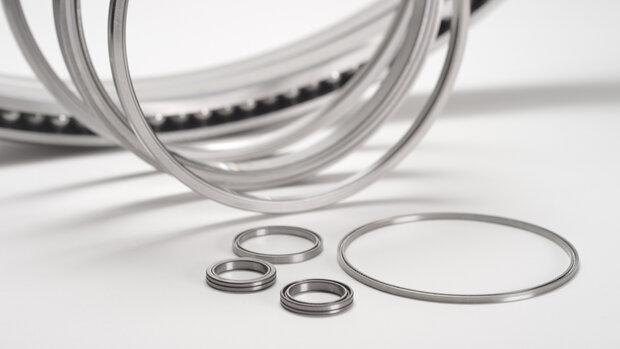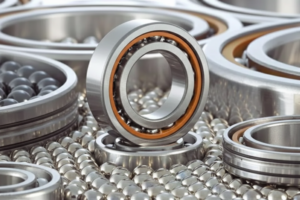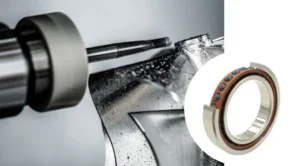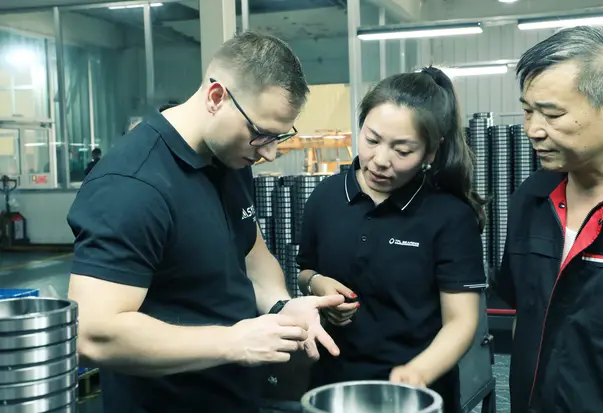Introduction
Imagine that we are building a castle using blocks. The blocks we use are not always the same size or shape.
Bearings are similar. Standard bearings are like universal, all-purpose blocks.
However, not every space can accommodate a standard bearing.
Thin section ball bearings are like specialized, delicate blocks designed for compact spaces. In equipment with tight structures, weight restrictions, and high precision requirements, these “thin blocks” make design possible. This article will explore what thin section ball bearings are, their characteristics, and their applications.

What are Thin section Ball Bearings?
Basic Definition
Thin section ball bearings were developed to solve problems where standard deep groove ball bearings are unsuitable, particularly in situations with limited space and weight concerns.
As the name suggests, thin section ball bearings are ball bearings with a small difference between their inner and outer diameters. Their thin wall thickness makes them compact and lightweight compared to conventional bearings.

There are multiple definitions for thin section ball bearings. Generally, a common definition is that a bearing is considered thin section when its bore diameter is more than four times larger than its radial cross-section. The cross-sectional size may vary but is typically twice the ball diameter.
Compared to standard-sized bearings, the radial cross-sectional height is very small, and the cross-section is square or approximately square. Due to their very thin inner and outer ring walls, thin section ball bearings are also known as thin wall bearings or thin profile bearings.

Load Capacity:
Compared to traditional bearings, thin-section ball bearings have limited load capacity and are mainly suitable for light to medium load applications. This is due to their thin-walled structure.
Common Models:
- Thin section deep groove ball bearings: 6900, 6800, 6700, 618, 619 series are all Thin section bearing series.
- Thin section angular contact ball bearings: 718, 719 series are also Thin section bearing series.
Structural Characteristics
Fixed Wall Thickness
For a specific series of thin section bearings, their wall thickness (i.e., outer diameter minus inner diameter) is fixed, even if the inner diameter increases, unlike the proportional growth of conventional bearings. The inner or outer diameter can be made very large while keeping the bearing size constant.
Thin-walled ring bearings offer high precision, quiet operation, and strong load capacity. These ball bearings come in three designs, are extremely small, and often have a square cross-section. In these series, even with larger shaft diameters and bearing bores, the cross-section remains constant. These bearings are, therefore, called constant section bearings.
Disadvantages/Challenges: Extremely high manufacturing precision is required, and their load capacity is relatively lower than traditional bearings.
Diverse Cross-Section Types: Including radial contact, angular contact, and four-point contact structures, meeting the needs of different working conditions.
Lightweight Design: Small volume and light weight, suitable for equipment with space constraints and high weight reduction requirements.

Classification of Thin Section Ball Bearings
- By Contact Type:
- Radial contact ball bearings (Deep groove ball type, Type C): Bear radial loads, and also small axial loads.
- Angular contact ball bearings (Type A): Bear combined radial and unidirectional axial loads, usually used in pairs.
- Four-point contact ball bearings (Type X): A single bearing can bear bidirectional axial loads, saving space. One bearing can replace two angular contact bearings.

- By Size Series: Such as open type KA, KB, KC, KD, KF series, each with a fixed wall thickness.
- By Material: Steel, ceramic, stainless steel, plastic retainers, etc.
- By Sealing: Available in open, sealed (ZZ or 2RS), or shielded forms, adapting to different environmental sealing requirements.
- Flexible Design:TFL offers customizable services to meet specific design requirements.
Performance Characteristics of Thin Section Ball Bearings
The main advantages of Thin section bearings include reduced weight and volume, increased load capacity, improved rigidity, reduced friction coefficient, lower energy loss, and extended mechanical life.
- High-Speed Performance: Low friction, suitable for high-speed rotating equipment.
- Low Torque: Low starting torque and operating resistance, suitable for energy-sensitive applications.
- High Rigidity and Stability: Despite thin walls, a reasonable design can still provide sufficient support rigidity.
- Low Noise and Low Vibration: High precision and meticulous manufacturing make them suitable for noise-sensitive applications like medical equipment.
- High Precision and Low Friction: Typically manufactured to high precision grades (P0, P6, P5, P4) to ensure smooth rotation.
Application Areas of Thin Section Ball Bearings
- Aerospace: Used in satellite mechanisms, attitude adjustment systems, gyroscopes, and inertial navigation systems due to their lightweight and high precision.
- Robotics and Automation Equipment: Used in joints, rotary platforms, and transmission modules to meet compact space and high precision requirements.
- Medical Equipment: CT scanners, MRI machines, surgical robots, etc., where cleanliness and low noise are critical.
- Military Equipment: Lightweight and precise motion components in missiles, radar, and fire control systems.
- Optical Equipment: Cameras, astronomical telescopes, optoelectronic scanning systems, requiring stable rotation and low vibration.
- Semiconductor Manufacturing Equipment: Requires extremely high cleanliness and precision, suitable for ceramic ball Thin section bearings.
- Rotary Worktables and Precision Machine Tools: Used for high-precision indexing and positioning functions.
- New Energy Equipment:
- Wind Turbines: Pitch and yaw systems (some models).
- Solar Tracking Systems: Drive mechanisms.
Conclusion
OK, this article introduces the above content for thin-walled ball bearings. Their special “thin wall” design helps bearings play a role in more scenarios. The clever design solves the problems that traditional bearings cannot solve, making our equipment smaller, lighter and more precise.
As an online bearing supplier in China, TFL Bearings provides a variety of thin-walled ball bearings. If you have special requirements for size, structure or material, we can meet customized needs.
Feel free to come and chat with us! We are happy to help find the solution that best suits your product and turn good ideas into reality together!





